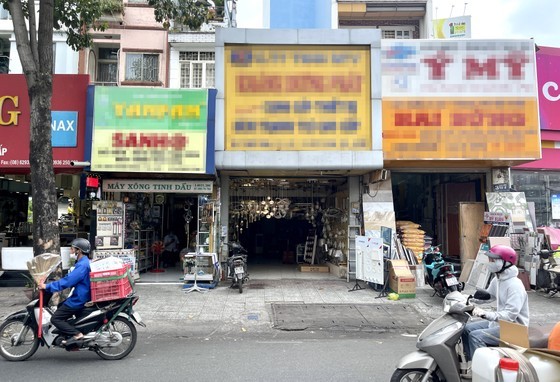 |
Building material stores in District 10 are poorly patronized. (Photo: SGGP) |
Market is muted
Despite opening since the tenth day of the Lunar New Year, so far, Khanh Binh construction material store in Le Van Khuong Street in District 12 in HCMC of Le Van Khanh can only sell a few truck-loads of sand and a few bags of cement for a four-level house under construction in a nearby alley.
“One or two months before the Tet holiday is usually the peak construction season. However, the number of construction works started was small, so I had to sell one of my trucks. It is forecasted that it will be even more difficult this year, so we do not replenish stock much," Khanh confided.
Similarly, Nguyen Van Binh, the owner of Thanh Binh building material store in Go Vap District, said that after the reopening day, his store imported sand and stone with two barge-loads of each type. According to the plan, these building materials would be sold out in the first month of the lunar calendar. However, in reality, the purchasing power is relatively weak. Thus, maybe until the beginning of the second quarter, the store will be able to sell out these building materials.
The weak consumption of building materials is also clearly shown by construction companies. Mr. Nguyen Van Khoat, Director of Viet Son Construction Company, said that after the Lunar New Year, the company only built projects received from last year, and there was no sign of new construction contracts. “This year is probably not better than last year.
There will be only civil construction contracts, while commercial projects are difficult to start because investors lack capital due to difficult situations. We are able to survive thanks to long-term partners. New customers are relatively rare," Mr. Khoat said.
According to many construction enterprises and contractors, up to now, very few new projects have been built because investors run out of capital, and it is hard to borrow money from banks. Some investors even are forced to negotiate with contractors to exchange products instead of paying cash for the work to be completed. “When constructing townhouses and villas for a real estate corporation in Phan Thiet, we are offered to receive apartments in exchange for construction costs.
Meanwhile, contractors do not have much capital. If we take apartments worth tens of billions of Vietnamese dong but cannot sell them, how will we manage to get money for other projects," said Mr. Nguyen Van Sang, Director of V.S. Construction, Trading, and Service Company in Go Vap District.
Increasing prices but still suffering losses
Although commercial and civil construction works are slow to start construction due to difficulties, prices of some key building materials have started to move up.
Specifically, from the beginning of 2023, the price of construction steel has increased four times, by about VND1.2 million-VND1.6 million per ton, depending on steel type and brand. Most recently, on February 7, several large steel brands, such as Hoa Phat, Pomina, Viet Italy, Kyoei, and Thai Nguyen, continued to raise their construction steel selling prices by VND200,000-400,000 per ton compared to January 31.
However, the steel price hike was not triggered by market demand but by the impact of increasing imported raw materials. According to the Vietnam Cement Association, domestic cement prices depend greatly on global fuel prices because nearly two-thirds of coal used in cement production must be imported. Therefore, the production cost in Vietnam relies heavily on the international market price of coal.
Besides, many other building materials are forecasted to escalate, which possibly creates great pressure on construction enterprises. According to statistics from the Ministry of Construction, prices of construction materials in 2023 are forecast to surge by 3.2 percent due to the increase in prices of input materials.
Mr. Nguyen Quang Cung, Chairman of the Vietnam Cement Association, forecasted that cement supply would reach 120.7 million tons in 2023, while the domestic demand for cement was only at 63-65.5 million tons.
Excess cement supply leads to increasingly fierce competition among cement manufacturers, and many units have to halt production or reduce productivity. That makes the profits of cement manufacturers continue to decrease, especially those located in areas with many cement factories with large output, such as Thanh Hoa, Nghe An, Ha Nam, and Ninh Binh.
Iron and steel also experience the same situation. According to the Vietnam Steel Association, the total steel consumption in 2022 reached 27.3 million tons, down 7.2 percent compared to 2021, and total steel exports were 6.28 million tons, down nearly 20 percent. Many steel companies, such as Hoa Phat, Hoa Sen, and Nam Kim, simultaneously reduced their inventories in the third and fourth quarters of 2022 when steel consumption faced many difficulties due to weak demand and falling steel prices.
For example, Hoa Phat sold 7.2 million tons of steel in 2022, 7 percent lower than the previous year. Steel sales volume in the second half was 20 percent lower than in the first half of 2022. To cut inventory, Hoa Phat had to temporarily close five steel blast furnaces in Dung Quat Complex and Hai Duong in November and December 2022.
Expecting driving force from public investment
According to a report from BSC Securities Company, public investment is an important growth driver in 2023. Specifically, the Ministry of Transport has set a target to focus on infrastructure development, with a disbursement plan 70 percent higher than that in the same period of last year.
It is estimated that about 400km of expressways at the North-South Expressway project phase 1 will be completed in 2023 and 2024. Besides, 729km of expressways in the North-South Expressway project phase 2 will also be put into operation in the 2023-2025 period, along with the construction of Long Thanh Airport. This is considered a driving force to bring the building materials industry back to life, replacing the rather gloomy civil construction sector.
























